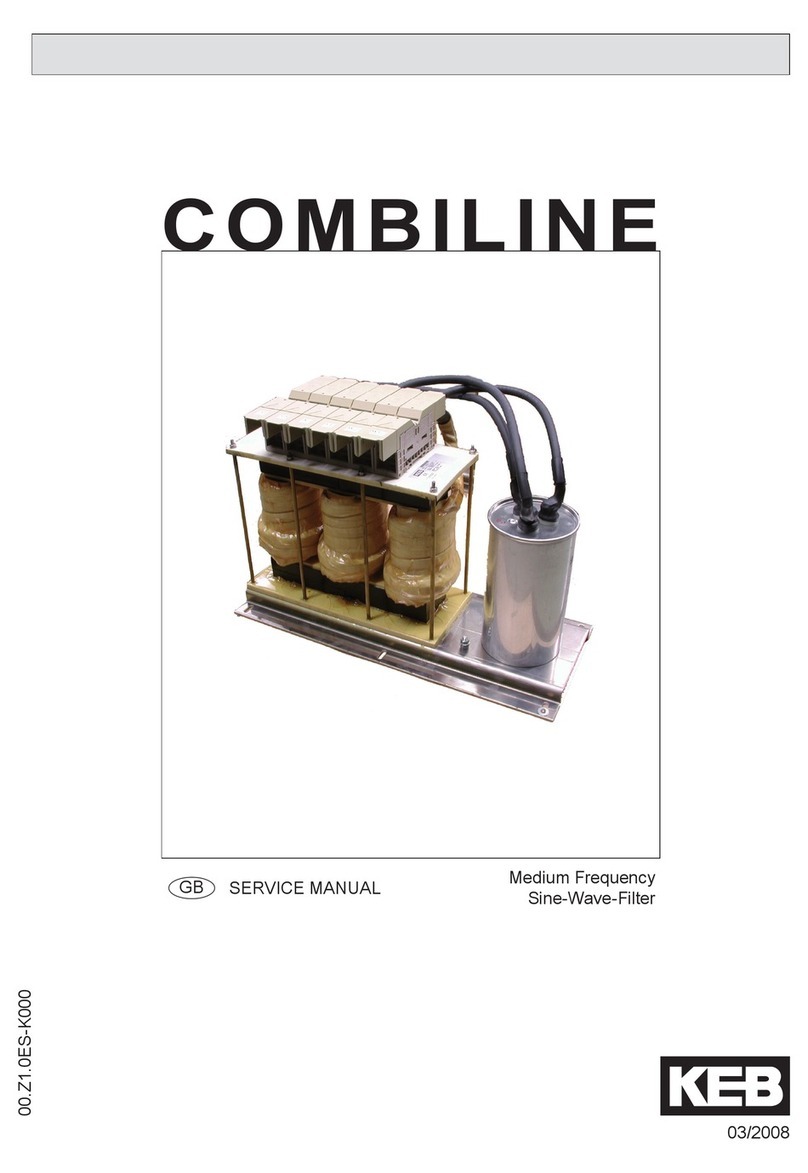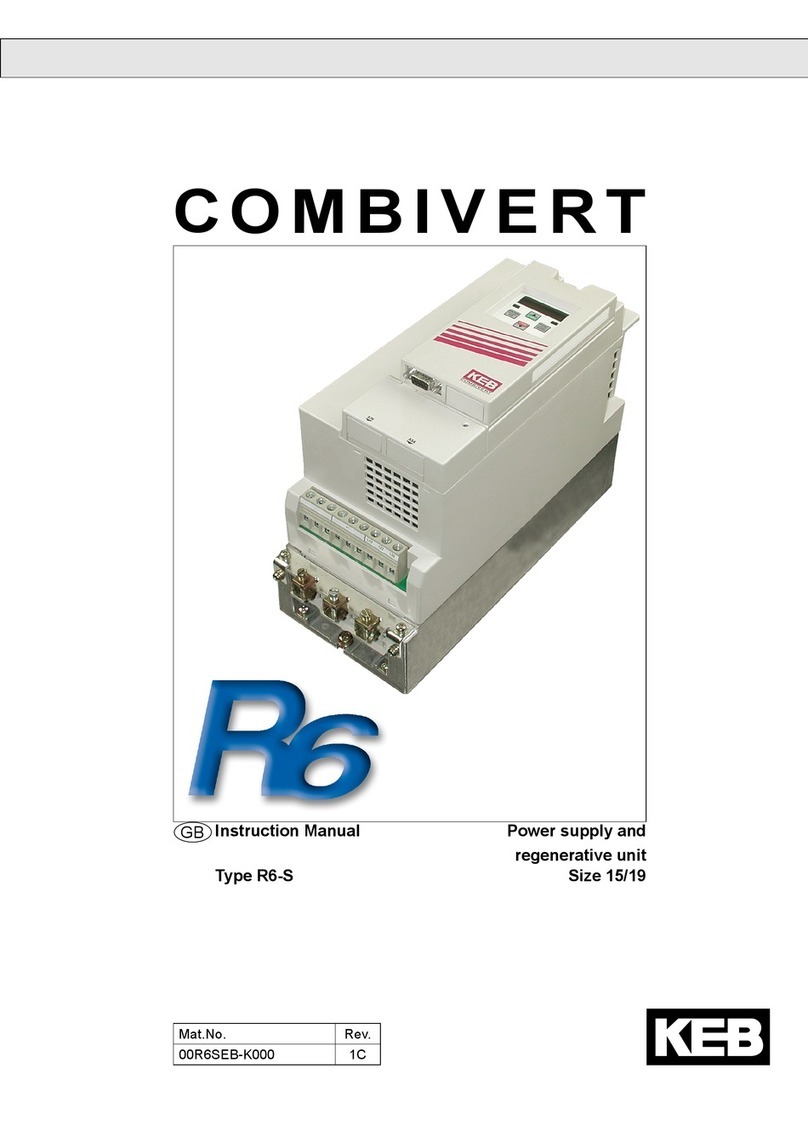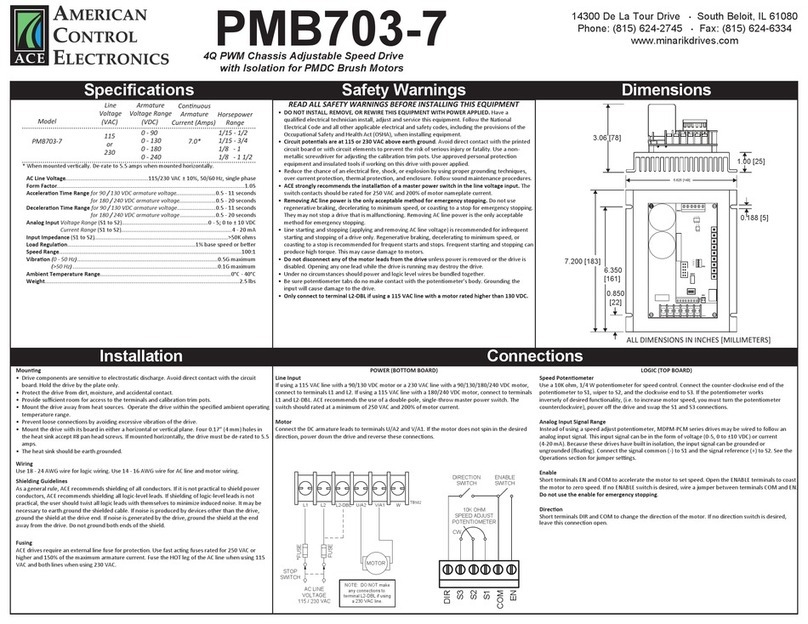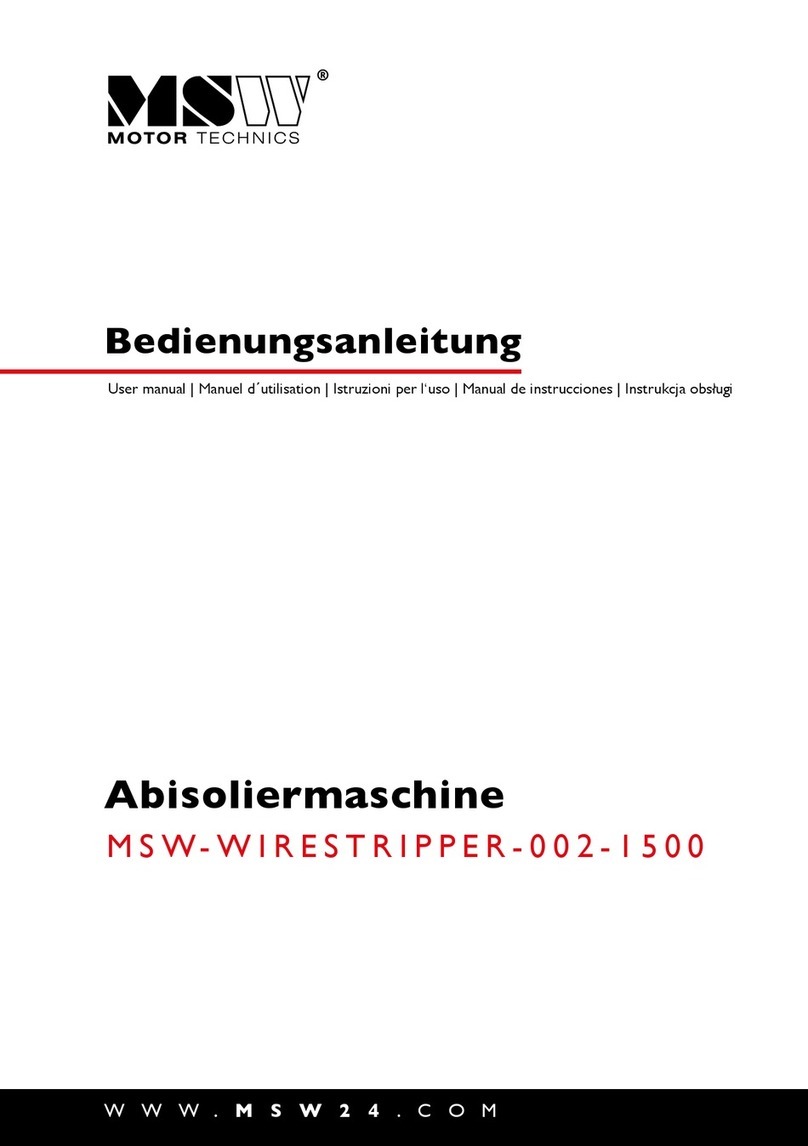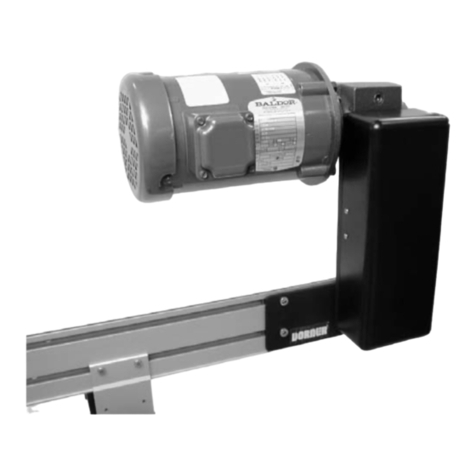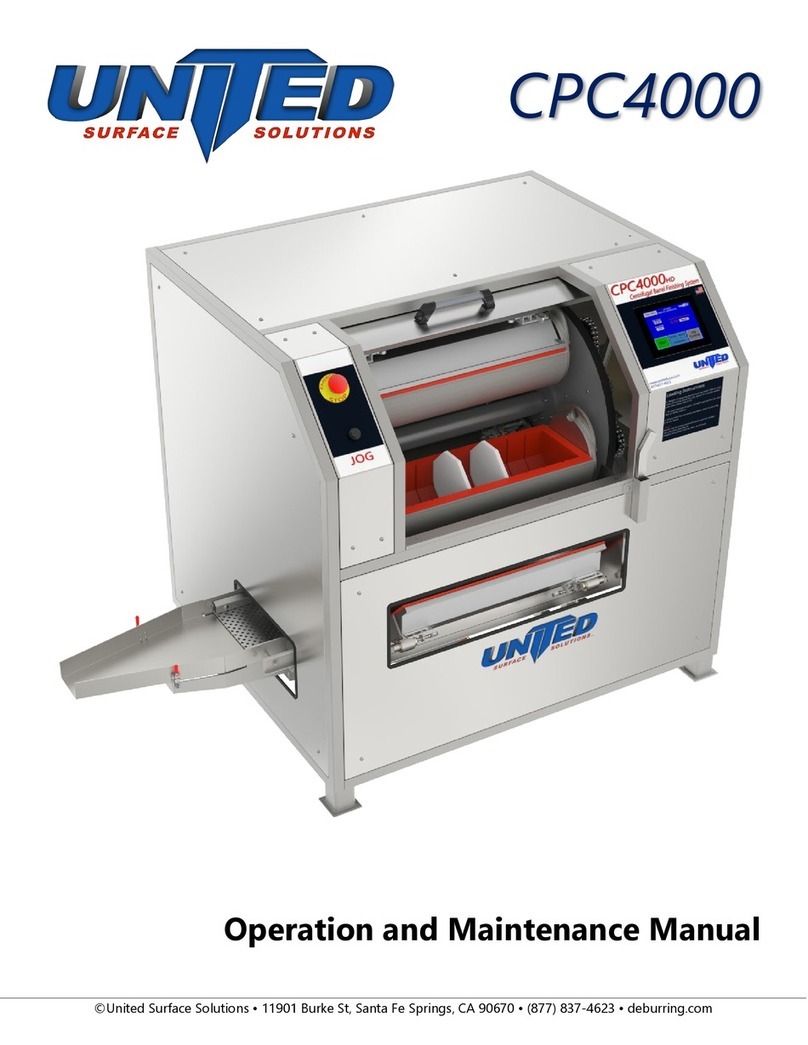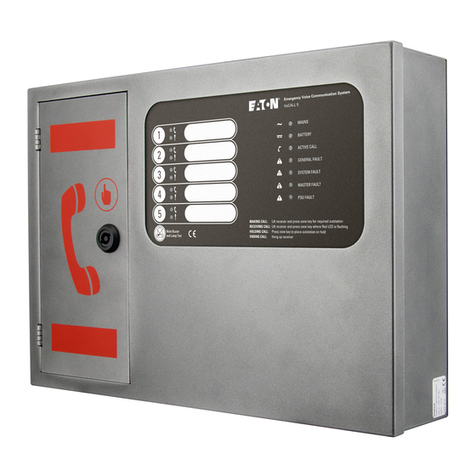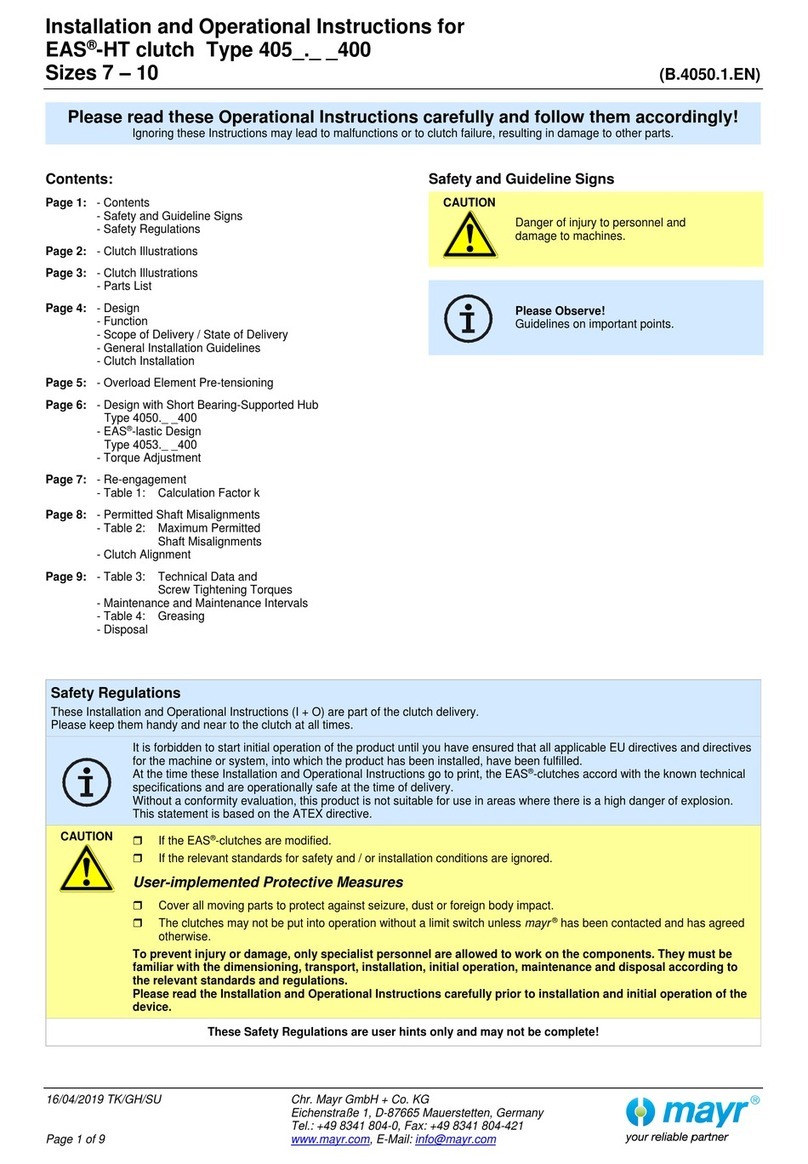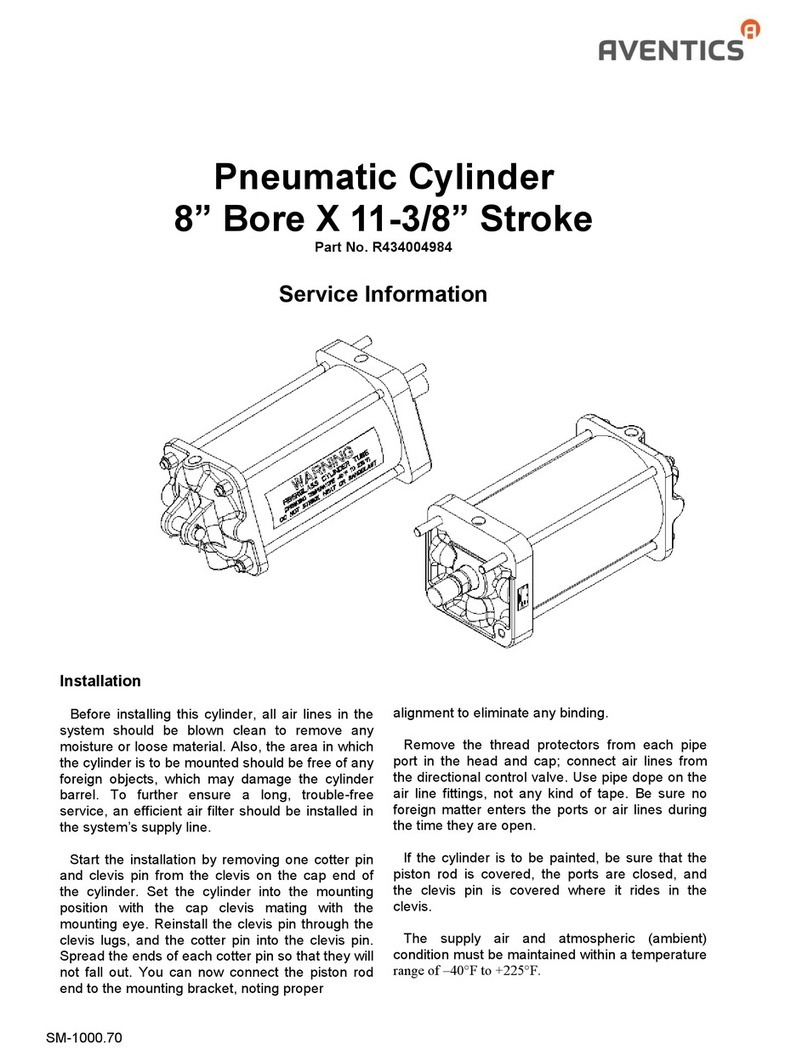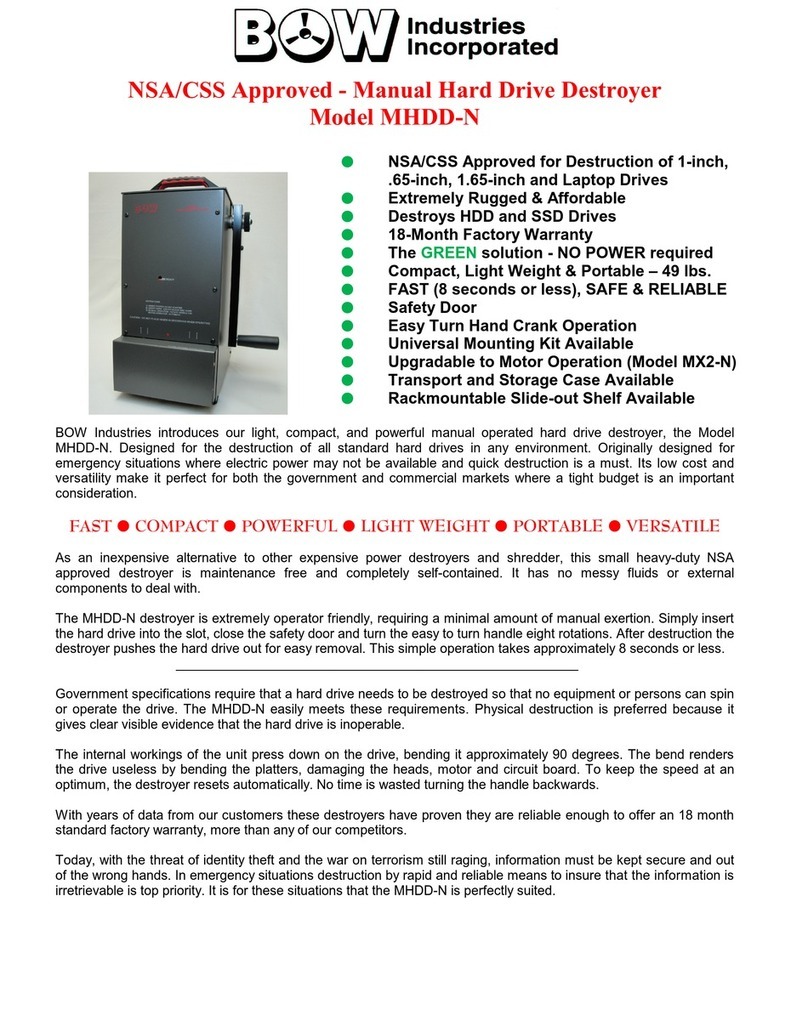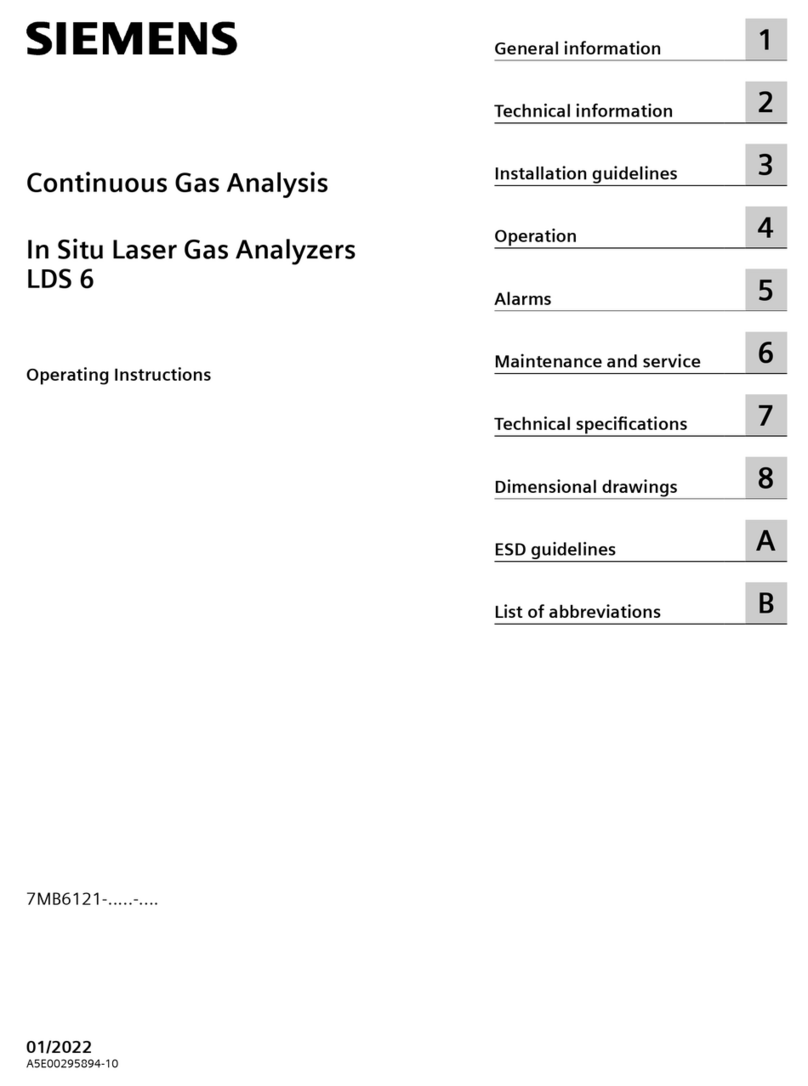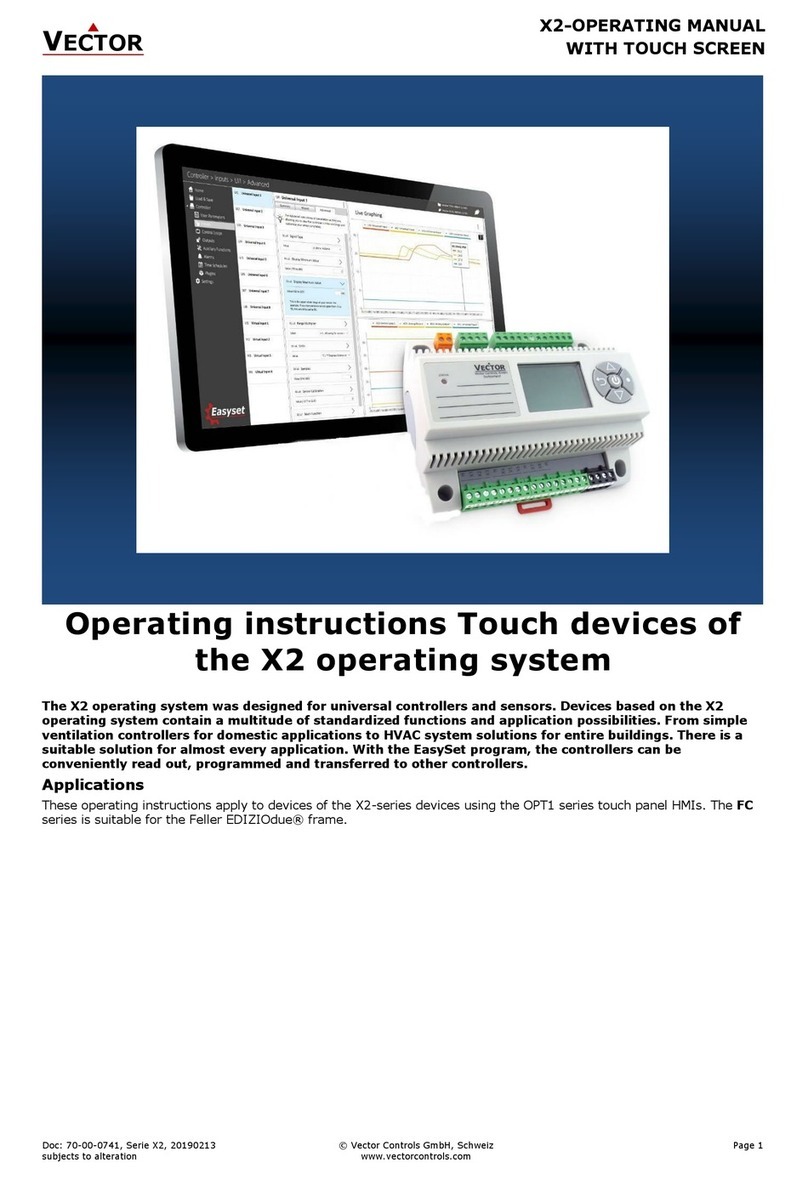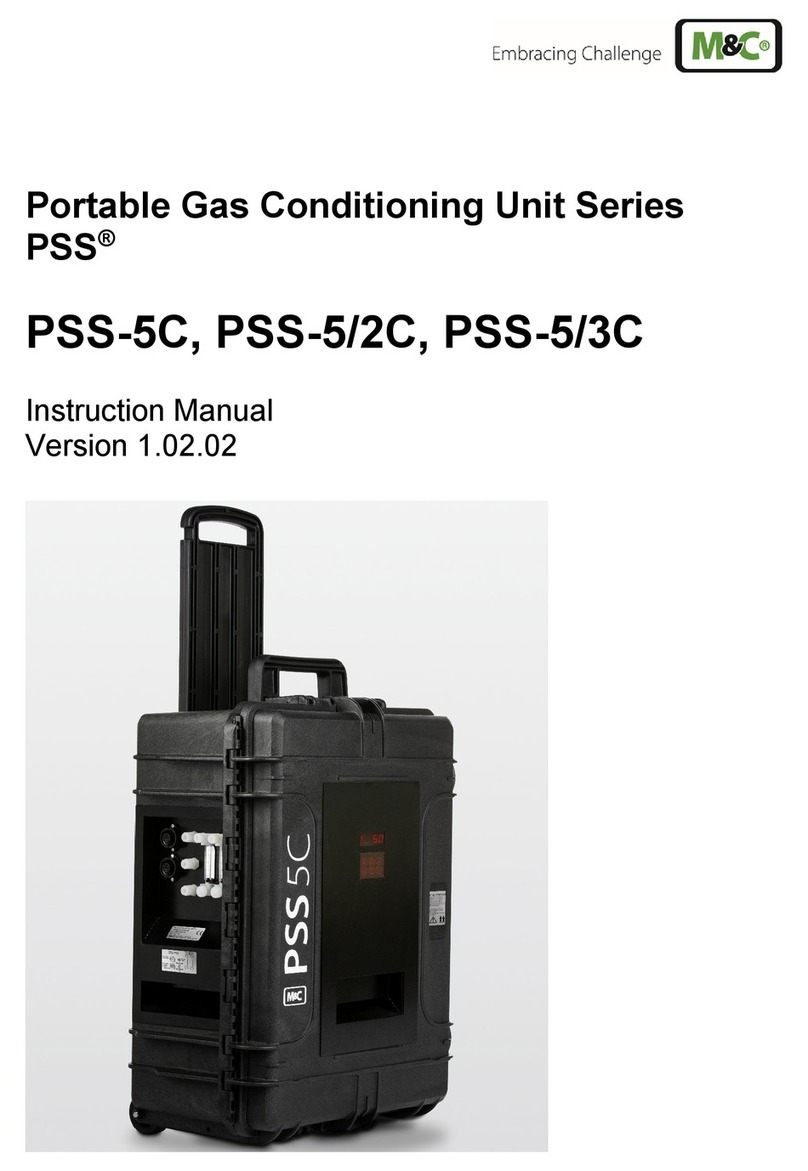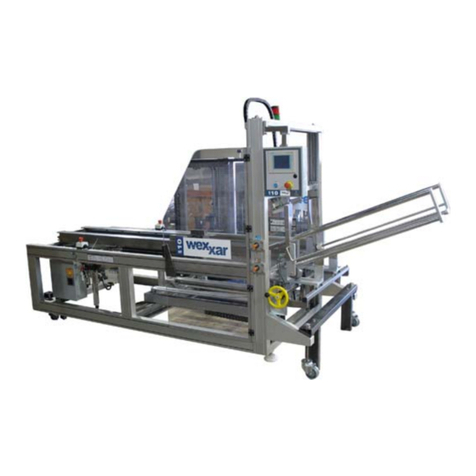KEBCO COMBISTOP User manual

COMBISTOP
INSTRUCTION MANUAL | Type 38 SPRING SET BRAKE
Original manual
COMBISTOP type 38
Document 20243560 000 01

2
©
2021 KEB America, Inc.

Preface
©
2021 KEB America, Inc.
3
1 Preface
The hardware and software described in this document are products of KEB America,
Inc. The information contained in this document is valid at the time of publishing. KEB
reserves the right to update this document in response to misprints, mistakes or technical
changes.
1.1 Warning Signs and Key Symbols
Certain procedures within this document can cause safety hazards during the installation or
operation of the device. Refer to the safety warnings in this document when performing these
procedures. Safety signs are also located on the device where applicable. A safety warning is
marked by one of the following warning signs:
DANGER
Dangerous situation which will cause death or serious injury if this
safety warning is ignored.
WARNING
Hazardous situation which may cause death or serious injury if
this safety warning is ignored.
CAUTION
Hazardous situation which may cause minor or moderate injury if
this safety warning is ignored.
NOTICE
Situation which may cause property damage if this safety warning
is ignored.
RESTRICTION Used when the following statements depend on certain conditions or
are only valid for certain ranges of values.
i
Used for informational messages or recommended procedures.
1.2 More Symbols
1. Numbered lists indicate action steps.
•Enumerations are marked with dots.
→Thin arrows indicate cross references to another chapter or another page.
Further documentation can be found at
https://www.kebamerica.com
Document search on www.kebamerica.com/em-
documents/

Table of Contents
4
©
2021 KEB America, Inc.
1.3 Laws and Requirements
KEB Automation KG has certified the product against the US, Canadian and European
standards. Additionally KEB Automation KG provides the EC declaration of conformity
that the product complies with the essential safety requirements.
The UL, CSA and CE marks are located on the name plate when applicable. The EC
declaration of conformity can be downloaded on demand via our website.
→Further information is provided in Appendix A: Certification.
1.4 Warranty
KEB Automation KG provides a limited warranty on all products. This warranty can be
found in the terms and conditions at our website.
KEB America, Inc. Terms and Conditions
Terms and Conditions
Further agreements or specifications require written confirmation from KEB America, Inc.
1.5 Support and Liability
It is not possible to cover every potential application of our device in a single manual. If
you require further information or if problems occur which are not covered in this
document, you can request the necessary information via KEB America, Inc. or the local
KEB Automation KG agency.
The use of our products in the target application is beyond our control and
therefore exclusively the responsibility of the machine manufacturer, system
integrator or customer.
The information contained in this document, as well as any user-specific advice in spoken
or written form or generated through testing, is provided to best of our knowledge and is
considered for informational purposes only. KEB America, Inc. bears no responsibility or
liability for the accuracy of the information listed above, nor for any violation of industrial
property rights committed by a third-party in relation to this information.
Selection of the most suitable product for any given application is the
responsibility of the machine manufacturer, system integrator or customer.
Evaluation of the product can only be performed by the machine manufacturer in
combination with the application. Any tests performed must be repeated every time any
part of the hardware or software is modified, or any time the unit adjustment is changed.
1.6 Copyright
The customer may use the information contained within this document for internal
purposes only. Copyright of this document is held by KEB America, Inc. and remains
valid in its entirety.
Other wordmarks or/and logos are trademarks (™) or registered trademarks (®) of their
respective owners and are listed in a footnote at the first occurrence.

Preface
©
2021 KEB America, Inc.
5
Table of Contents
1Preface ...................................................................................................3
1.1 Warning Signs and Key Symbols ................................................................... 3
1.2 More Symbols................................................................................................... 3
1.3 Laws and Requirements.................................................................................. 4
1.4 Warranty............................................................................................................ 4
1.5 Support and Liability ....................................................................................... 4
1.6 Copyright .......................................................................................................... 4
Table of Contents ....................................................................................................... 5
List of Figures............................................................................................................. 8
Glossary...................................................................................................................... 9
Standards for COMBISTOP type 38 Brakes ........................................................... 12
2Safety Instructions..............................................................................13
2.1 Target Audience ............................................................................................. 13
2.2 Specified Application..................................................................................... 13
2.3 General Safety Guidelines............................................................................. 14
2.4 Electrical Safety Guidelines .......................................................................... 14
2.5 Installation and Operation Safety Guidelines .............................................. 14
2.6 Maintenance Safety Guidelines .................................................................... 15
2.7 Personal Protective Equipment .................................................................... 16
2.8 Permissible Friction Work ............................................................................. 17
3Product Description............................................................................18
3.1 Scope of this Manual ..................................................................................... 18
3.2 Description ..................................................................................................... 18
3.3 Torque and Operating Power ........................................................................ 19
3.4 Parts List......................................................................................................... 20
3.5 Optional Safety Devices ................................................................................ 21
3.5.1 Microswitch............................................................................................................................ 21
3.5.2 Hand Release Lever .............................................................................................................. 21
3.5.3 Lifting Tab .............................................................................................................................. 21

Table of Contents
6
©
2021 KEB America, Inc.
4Transport and Storage .......................................................................22
4.1 Inspection on Delivery ................................................................................... 22
4.2 Unloading and Moving the Device................................................................ 22
4.3 Packaging ....................................................................................................... 22
4.4 Temporary Storage ........................................................................................ 22
5Installation ...........................................................................................23
5.1 Before You Begin ........................................................................................... 23
5.2 Mounting Surface Requirements .................................................................. 24
5.3 Installing the Brake ........................................................................................ 24
5.4 Electrical Connection .................................................................................... 28
5.4.1 Connecting the Brake with Rectifier ................................................................................... 28
5.4.1.1 AC Side Switching........................................................................................................... 29
5.4.1.2 DC Side Switching........................................................................................................... 30
5.4.1.3 DC Side Switching with External MOV............................................................................ 31
5.4.2 Switching Cycles and Times................................................................................................ 32
5.5 Uninstallation of the Brake............................................................................ 34
5.5.1 Brake Disposal ...................................................................................................................... 34
6Optional Components ........................................................................35
6.1 Hand Release Lever ....................................................................................... 35
6.1.1 Installing the Hand Release Lever....................................................................................... 36
6.2 Microswitch .................................................................................................... 38
6.2.1 Microswitch Replacement .................................................................................................... 39
6.2.2 Adjusting the Microswitch Settings .................................................................................... 40
7Operation .............................................................................................41
7.1 Before You Begin ........................................................................................... 41
7.1.1 Running-In Process .............................................................................................................. 41
7.2 Manual Operation........................................................................................... 42
8Maintenance and Troubleshooting ...................................................43
8.1 Maintenance ................................................................................................... 43
8.1.1 Checking the Air Gap............................................................................................................ 43
8.1.2 Adjusting the Air Gap ........................................................................................................... 45

Preface
©
2021 KEB America, Inc.
7
8.1.3 Replacing the Friction Lining............................................................................................... 46
8.2 Torque Adjustment ........................................................................................ 47
8.3 Troubleshooting............................................................................................. 48
9Appendix..............................................................................................49
9.1 Appendix 1: Technical Specifications .......................................................... 49
9.2 Appendix 2: Certification............................................................................... 50
9.3 Appendix 3: Revision History ....................................................................... 51

List of Figures
8
©
2021 KEB America, Inc.
List of Figures
Figure 1 Friction Switching Frequency Red line for brake without friction disk ......................................... 17
Figure 2 Brake Parts List............................................................................................................................. 20
Figure 3 Brake with Flange ......................................................................................................................... 24
Figure 4 Brake with Friction Disk ................................................................................................................ 24
Figure 5 Mounting the Hub.......................................................................................................................... 25
Figure 6 Gap between Hub and Friction Surface........................................................................................ 25
Figure 7 Air Gap.......................................................................................................................................... 27
Figure 8 Rectifier Wiring: Independent Supply ........................................................................................... 29
Figure 9 Rectifier Wiring: Motor Supply ...................................................................................................... 29
Figure 10 Rectifier Wiring: Phase to Phase ................................................................................................ 29
Figure 11 Rectifier Wiring: DC Switching.................................................................................................... 30
Figure 12 Rectifier Wiring: External MOV ................................................................................................... 31
Figure 13 Hand Release Lever Parts.......................................................................................................... 35
Figure 14 Microswitch Parts........................................................................................................................ 38
Figure 15 Hand Release Lever Operation .................................................................................................. 42
Figure 16 Checking the Air Gap.................................................................................................................. 43
Figure 17 Wear Dimensions........................................................................................................................ 44
Figure 18 Adjust the Air Gap....................................................................................................................... 45
Figure 19 Removing the Magnet System.................................................................................................... 46
Figure 20 Size 02 - 06 with E-Ring ............................................................................................................. 47
Figure 21 Size 07 - 11 with Set Screws ...................................................................................................... 47

Preface
©
2021 KEB America, Inc.
9
Glossary
AC Alternating current.
Aggressive Fumes/Liquids
Gasses or liquids that are chemically reactive and may cause
corrosion in exposed machine parts.
Air Gap
The gap between the armature and the magnet. This air gap must
be precisely calibrated to a specific width, denoted as X. If the air
gap is too wide, the braking torque is reduced. If the air gap is too
narrow, the brake may not release correctly.
Application
The machine/system in which the KEB device is to be used. For
brakes the application is typically the motor to which the brake is
attached.
Armature The component of the brake which rotates with the driven
shaft/surface and presses against the magnet to engage the
brake.
AWG / Wire Gauge
American Wire Gauge. A measure of the thickness of a wire using
standardized sizes.
Branch Circuit Protection
Circuit protection for the portion of the electrical distribution
system that extends beyond the final branch circuit protection
device. A branch circuit is used to run motors or other appliances,
and is what is commonly found inside a building.
CE
European safety standards for products in the European
Economic Area. Manufacturers self-test products against these
standards to maintain CE certification. The CE mark indicates a
product meets EEA safety standards.
CEC
Canadian Electric Code. Safety standard for electrical installations
used in Canada.
Control Device/Interface
The COMBISTOP brake is controlled electronically by a control
device. This can be as simple as a switch, or as complex as a full
suite of control software.
CSA Canadian Standards Authority, also known as CSA Group.
Organization that tests and certifies products according to
Canadian safety standards. The CSA mark indicates a product
meets Canadian safety standards.
Customer The corporation or individual who purchased the COMBISTOP
brake.
DC Direct current.
Device / KEB Device
The COMBISTOP brake described in this manual.
Drive Shaft A mechanical component for transmitting torque and rotation from
a motor to other parts of a mechanical system.

Glossary
10
©
2021 KEB America, Inc.
Driven Shaft/Surface
A rotating component of a mechanical system which is driven by a
drive shaft. Typically connected to the drive shaft via a clutch to
allow the driven shaft/surface to be engaged when needed. The
driven shaft/surface refers to the component directly connected to
the drive shaft. See Load for a broader term for all parts of the
system driven by the motor.
Dry running
Operation in dry environments with no danger of dripping or
splashing liquids.
EC Declaration of
Conformity
Declaration that the device conforms to EU standards of safety.
Equipotential Bonding
A practice of intentionally electrically connecting all exposed metal
items not designed to carry electricity in a room as protection from
electric shock.
Flange An external flat rim or ridge for attaching an external object to the
device.
Friction Surface The component of the brake against which the friction lining
presses to provide braking torque. This can be the mounting
surface directly, or it can be a flange or friction disk provided by
KEB.
KEB Automation KG Parent company of KEB America, Inc. Also referred to as KEB.
Load
The components of a mechanical system driven by a motor. The
load refers to the entire system powered by the motor. See Driven
Shaft/Surface for the individual component connected directly to
the drive shaft.
Machine Manufacturer The manufacturer of the application in which the COMBISTOP
brake is installed. Not KEB America, Inc.
Magnet The component of the brake which contains the magnetic
components.
Mounting Surface A surface to which the COMBISTOP device is physically
attached. The COMBISTOP is typically attached to the mounting
surface with the recommended socket-head screws, but other
fastening methods may be used as appropriate to the application.
NEC US National Electric Code. Safety standard for electrical
installations used in the United States.
Product / KEB Product
See Device.
Recommended tightening
torque
The torque required to fully screw a socket head screw into a
mounting surface. The recommended tightening torque depends
on the type of screw used as well as the material, thread depth
and locking components (if any) used in the mounting surface.
Refer to the machine manufacturer for details on recommended
tightening torques for specific mounting surfaces.
Run-out An inacuracy of rotating mechanical systems whereby the shaft
does not rotate precisely in line with the main axis. Always
present but must be minimized.

Preface
©
2021 KEB America, Inc.
11
Specified Application
The specific application for which the COMBISTOP device was
ordered, is usually (but not always) the same as the Application in
which the device is being used.
System Integrator The technician installing the COMBISTOP brake into the
application.
UL Independent Standardization Company that tests and certifies
products according to defined and industry leading safety
standards. The UL mark indicates a product meets UL safety
standards.

Glossary
12
©
2021 KEB America, Inc.
Standards for COMBISTOP type 38 Brakes
The COMBISTOP installation must comply with all relevant safety standards. The
following standards are relevant to the installation and operation of the COMBISTOP type
38 Brake.
•Directive 2006/42/EC (annex I)
oRegion: EU
oEssential health and safety requirements for the design and construction of
machinery.
•C22.1-18: Canadian Electric Code, Part 1 (CEC)
oRegion: Canada
oElectric safety code detailing safety standards for electric installations in
Canada.
•NFPA 70: National Electric Code (NEC)
oRegion: US
oElectric safety code detailing safety standards for electric installations in the
United States.
•NFPA 79: Electrical Standard for Industrial Machinery
oRegion: US
oIndustrial safety code detailing safety standards for industrial machinery to
protect against fire and electrical hazards.
•OSHA 1910.137
oRegion: US
oPersonal safety code detailing appropriate personal protective equipment for
working on electrical installations.
•OSHA 1910.269
oRegion: US
oOccupational safety code detailing safety standards for electrical power
generation, transmission, and distribution.

Safety Instructions
©
2021 KEB America, Inc.
13
2 Safety Instructions
The COMBISTOP is designed and constructed with state-of-the-art technology in
accordance with recognized safety rules and regulations. Improper use of this device
may cause hazards to life and limb of the user or third-parties, or damage to the
application and other material property.
The following safety instructions have been created by KEB America, Inc. for the
COMBISTOP type 38 brake. These instructions can be supplemented by local, country-
or application-specific safety instructions where relevant.
Violation of the safety instructions in this manual will result in the loss of any liability
claims.
NOTICE
Stay Safe! Stay Informed!
Read the instruction manual prior to operating the device!
Follow all safety and warning instructions!
If you are unsure of any part of these instructions, please contact
KEB prior to operating the device!
2.1 Target Audience
This manual is intended exclusively for the use of qualified electrical/mechanical
technicians. Qualified technicians for the purpose of this document must meet the
following:
•Must have fully read and understood the safety instructions contained in this manual.
•Must be familiar with the installation and assembly of electrical products.
•Must be familiar with the installation and operation of the product as specified in this manual.
→See the Installation and Operation chapters for details.
•Must fully understand the specified application of the product.
→See the Specified Application section for details.
•Must be familiar with the hazards and risks of mechanical brake technology.
•Must be familiar with appropriate electrical and safety codes:
oUS: NFPA 70 National Electric Code (NEC)
oCanada: Canadian Electric Code, C22 Part 1 (CEC)
•Must be familiar with national safety regulations (e.g. OSHA Title 29 CFR):
→See the Standards for COMBISTOP type 38 Brakes section for details.
2.2 Specified Application
The operational reliability of the brake is only guaranteed when the device is used for the
specified application. In this context, specified application means the purpose for which
the brake was ordered and configured.

Safety Instructions
14
©
2021 KEB America, Inc.
Any use of the brake outside of this specified application is considered at the user’s own
risk. Such unintended uses may pose unforeseeable risks or hazards. KEB America, Inc.
retains no liability for any damage or injury resulting from the use of a COMBISTOP
brake outside of the specified application.
2.3 General Safety Guidelines
Carefully observe the following safety guidelines before installation or operation of the
device.
•Only trained personnel should operate the brake.
•Immediately remove the brake from operation in case of a malfunction.
•Malfunctions should be corrected by trained personnel before returning the brake to
operation.
•Never use the brake in potentially explosive environments.
•The brake may not be modified or altered in any way not intended by KEB America, Inc.
2.4 Electrical Safety Guidelines
DANGER
Rick of electrical shock!
Turn off the power supply and secure it against switching on prior
to any work on the device.
Wait until the system has come to a complete stop prior to any
work on the device.
Never bridge branch circuit protection devices.
•Observe all relevant safety standards during the electrical installation.
→See the Standards for COMBISTOP type 38 Brakes section for details
specific to the product.
•Use only wire gauges and fuses rated for the power requirements of the device.
•Ensure new or existing circuits meet NEC or applicable local requirements.
•The device must be appropriately grounded by a connector from the magnet and the fixed
installation.
•When using components without isolated inputs/outputs, equipotential bonding must be used
between the connected components to prevent damage to the device.
•Do not exceed specified electrical voltage and currant limits.
→See Appendix 1: Technical Specifications for details.
2.5 Installation and Operation Safety Guidelines
WARNING
Moving parts can crush and cut!
Contact with rotating or moving parts may cause serious injury.
Ensure adequate protection around the brake to prevent
accidental contact!

Safety Instructions
©
2021 KEB America, Inc.
15
CAUTION
Hot Surfaces!
The heat generated during the operation of the brake may cause
burns on contact with skin. Always wear appropriate protective
equipment!
Do not start the device until you have confirmed that the installation complies with the
following safety standards.
•Ensure there is sufficient protection against foreign particles entering the air gap. These
particles may impede the motion of the armature.
•Ensure there is sufficient thermal protection such that the brake does not exceed or fall below
the listed temperature limits for the device.
→See Appendix 1: Technical Specifications for details.
•Ensure there is protection against accidental contact with rotating or moving parts.
•Ensure there is sufficient protection from environmental factors such as moisture or
aggressive gases that may compromise the integrity of the friction surface or armature.
2.6 Maintenance Safety Guidelines
DANGER
Risk of electrical shock!
Turn off the power supply and secure it against switching on prior
to any maintenance on the brake.
WARNING
Moving parts can crush and cut!
Contact with rotation or moving parts may cause serious injury.
Wait until the drive has come to a complete stop before
performing any maintenance.
Secure the drive against accidental movement prior to
performing any maintenance.
CAUTION
Hot Surfaces!
The heat generated during the operation of the brake may cause
burns on contact with skin. Always wear appropriate protective
equipment.
Carefully observe the following safety guidelines before performing maintenance on the
brake.
•Ensure the device is powered off and has come to a complete stop before performing any
maintenance.
•Secure the brake so it cannot be switched on accidentally during maintenance.
•Disconnect the brake from the load before maintenance to avoid uncontrolled movements.
•Ensure there is sufficient protection against foreign particles entering the air gap during
maintenance.
•Ensure there is sufficient protection against moisture or aggressive gasses that may
compromise the integrity of the friction surface or armature.

Safety Instructions
16
©
2021 KEB America, Inc.
•Ensure the friction lining does not come into contact with cleaning agents or solvents.
2.7 Personal Protective Equipment
When installing or performing maintenance on the brake, use the following personal
protective equipment:
•Long-sleeved protective clothing
•Safety gloves
•Safety shoes
•Safety goggles
The personal protective equipment must be provided by the operating company and must
comply with any applicable safety regulations.
→See Standards for COMBISTOP type 38 Brakes for details.

Safety Instructions
©
2021 KEB America, Inc.
17
2.8 Permissible Friction Work
When operating the brake adhere to the friction work values specified below, taking the
speed and frequency of operation into account. Exceeding these specifications may
result in thermal overload of the lining and a strong decrease in braking torque.
NOTICE
The WRmax table below is only valid for standard brakes with a
secondary friction surface of cast steel.
Rust-free secondary friction surfaces or speeds higher than
specified will reduce the permissible friction work. If rated torque
is reduced by optional adjustment screws, the permissible work
will increase.
Permissible Friction Work Values
Size Range
Speed
00 – 07
3000 rpm
08 – 11
1500 rpm
Figure 1 Friction Switching Frequency
Red line for brake without friction disk

Product Description
18
©
2021 KEB America, Inc.
3 Product Description
3.1 Scope of this Manual
This manual provides all information required to properly install and operate the KEB
COMBISTOP type 38 Spring Set Brake. This manual applies to the following brake types:
•COMBISTOP type 38.11N
oWithout hand release for dynamic applications (regular rated torque)
•COMBISTOP type 38.13N
oWith hand release for dynamic applications (regular rated torque)
•COMBISTOP type 38.11H
oWithout hand release for static applications (enhanced rated torque)
•COMBISTOP type 38.13H
oWith hand release for static applications (enhanced rated torque)
i
The type designation can be found on the type plate attached to
the lead wires and in the model number of the device.
Device part numbers follow the format XX.YY.ZZZ where
oXX = Size
oYY = Type
oZZZ = Design
3.2 Description
The COMBISTOP type 38 brake is an electromagnetically activated dual-surface spring-
applied brake for dry operation. The brake is engaged when powered OFF, and
disengaged when powered ON.
The braking force is generated when the brake is powered OFF by pressure springs
which press the armature and friction lining against the friction surface. The friction lining
will move axially on the hub. This allows the armature to apply pressure to the flange or
friction surface through the friction lining to provide braking torque.
After applying the nominal DC voltage to power the brake ON, the electromagnet attracts
the armature against the spring force, releasing the friction lining and disengaging the
brake.
Using the optional hand release lever the brake can be manually disengaged in the case
of a power failure or other malfunction.

Product Description
©
2021 KEB America, Inc.
19
3.3 Torque and Operating Power
The COMBISTOP comes in a variety of sizes to meet the braking needs of the specified
application. Braking torque and operating power by brake size is shown below.
Brake
Size
Rated Braking Torque1)
[Nm]
Wattage
[W]
Type N Type H Type N Type H
00 0.5 - 2 11 - 15
02 5 7.5 25 25
03 10 15 30 30
04 20 30 30 30
05 36 50 48 48
06 70 90 62 75
07 100 150 65 90
08 150 225 75 90
09 250 375 80 115
10 500 750 130 180
11 1000 1500 180 280
1) After running-in process

Product Description
20
©
2021 KEB America, Inc.
3.4 Parts List
Figure 2 Brake Parts List
•A: Brake sizes 02 to 06
•B: Brake sizes 07 to 11
Number
Description
1 Magnet System
1.1
Magnet
1.2 Adjusting Spacer
1.3
Armature
2a Fingered Hub (for size A brakes)
2b Splined Hub (for size B brakes)
3a
Molded Friction Lining (for size A brakes)
3b Splined Friction Lining with Aluminum Carrier (for size B brakes)
4 Friction Disk (Optional)
5 Flange (Optional)
6 Hand Release Lever (Optional)
7 Dust Protection Ring (Optional)
Table of contents
Other KEBCO Industrial Equipment manuals
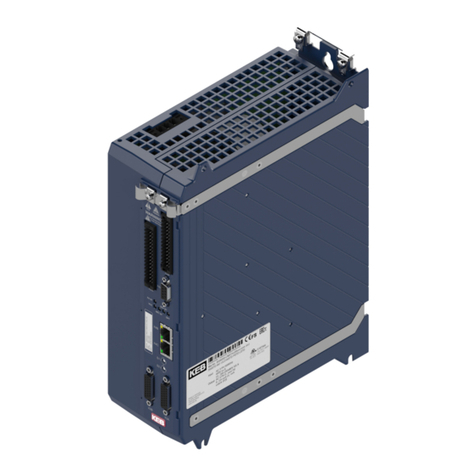
KEBCO
KEBCO COMBIVERT S6 Series User manual
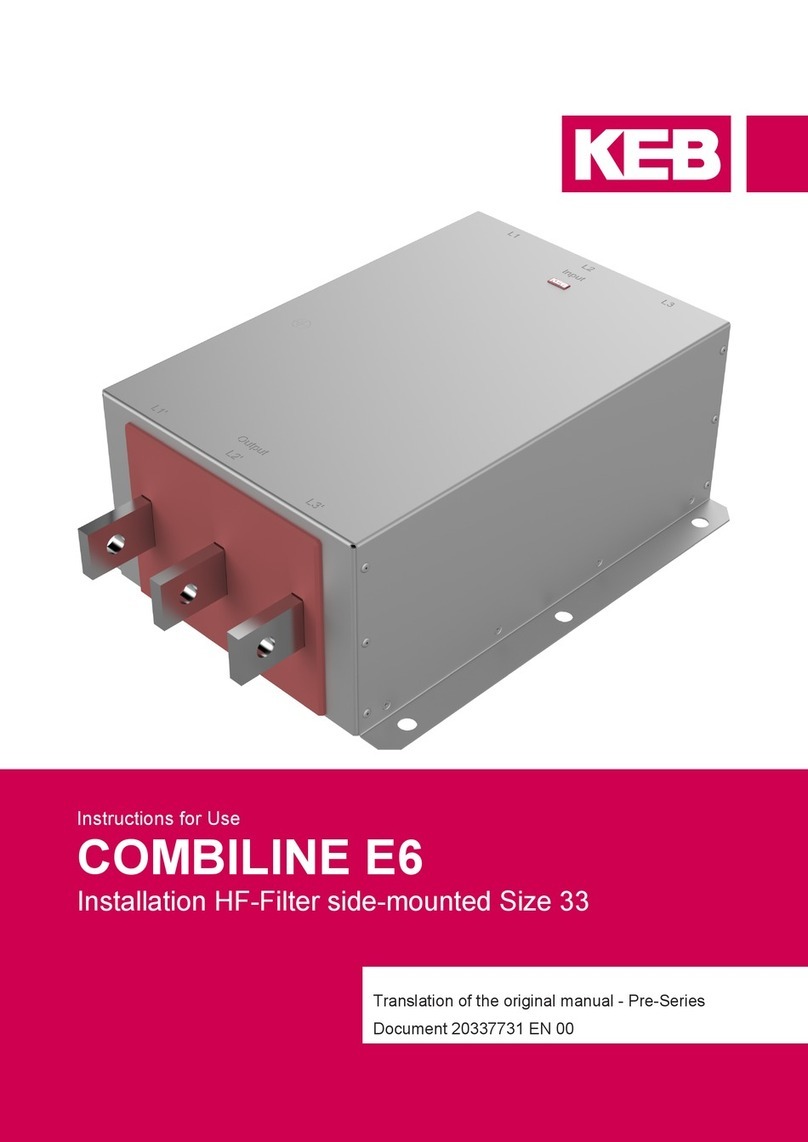
KEBCO
KEBCO COMBILINE E6 Series User manual
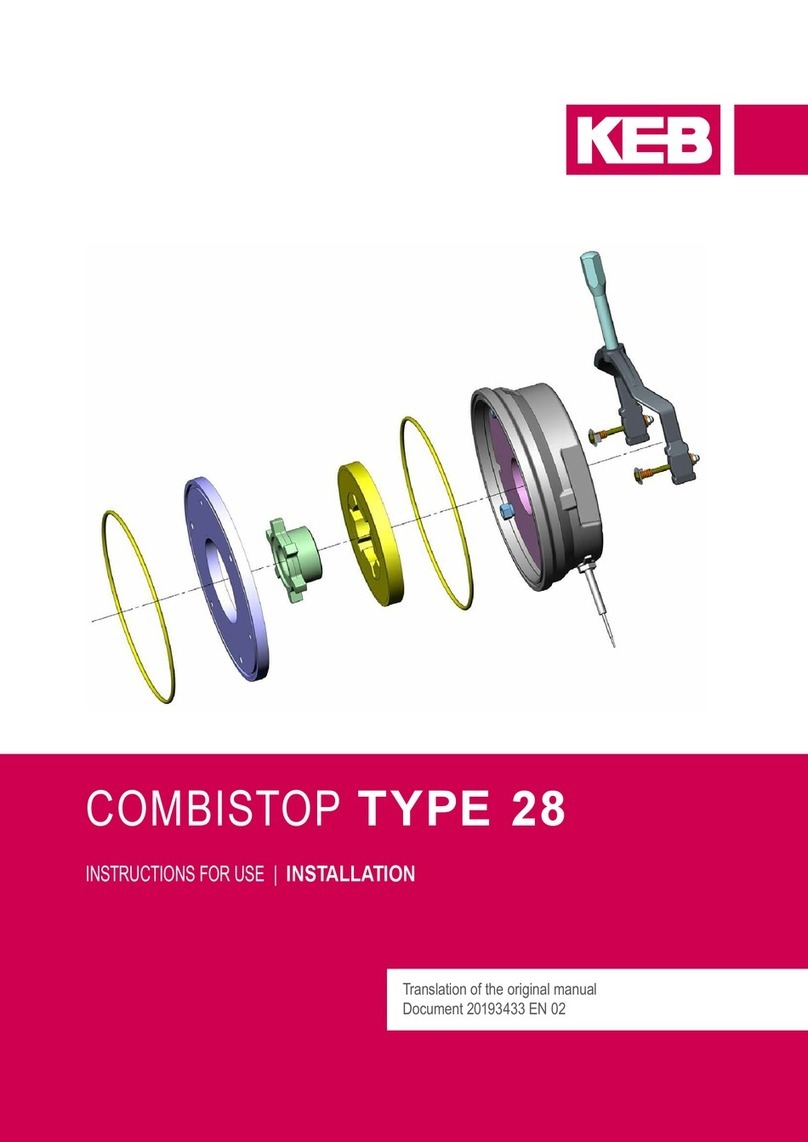
KEBCO
KEBCO COMBISTOP 28 User manual

KEBCO
KEBCO COMBISTOP 38 User manual
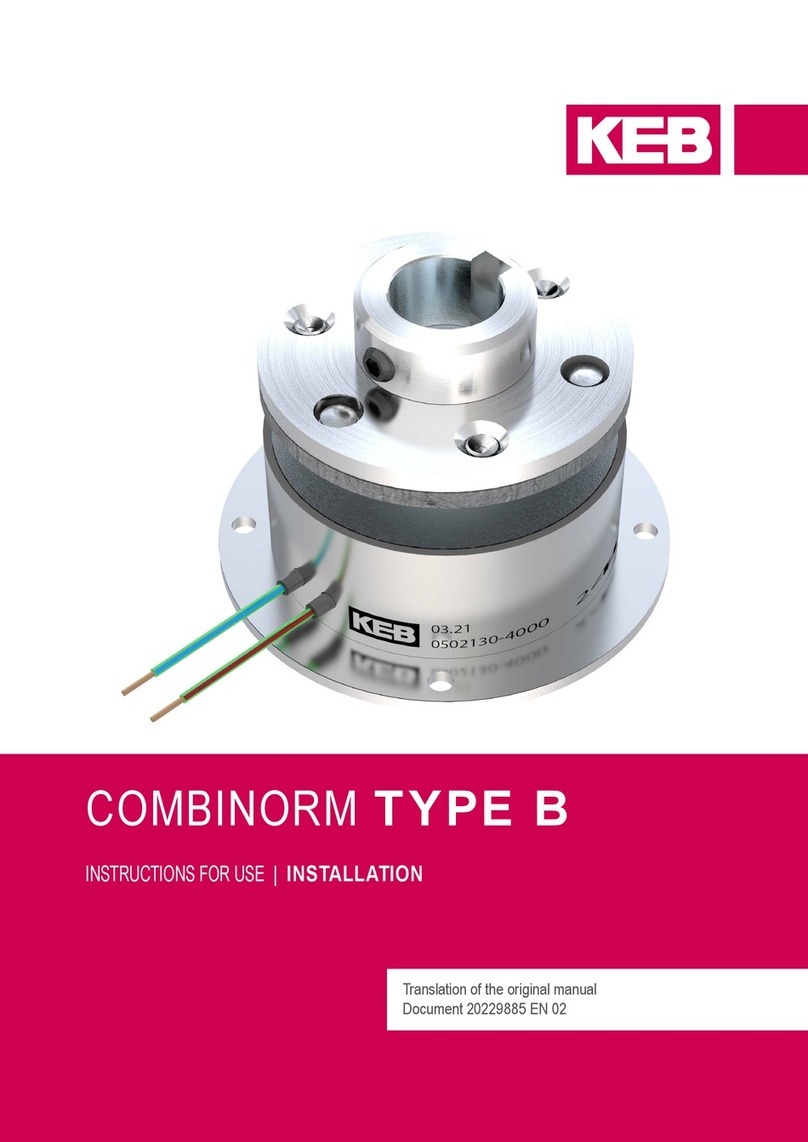
KEBCO
KEBCO COMBINORM B User manual
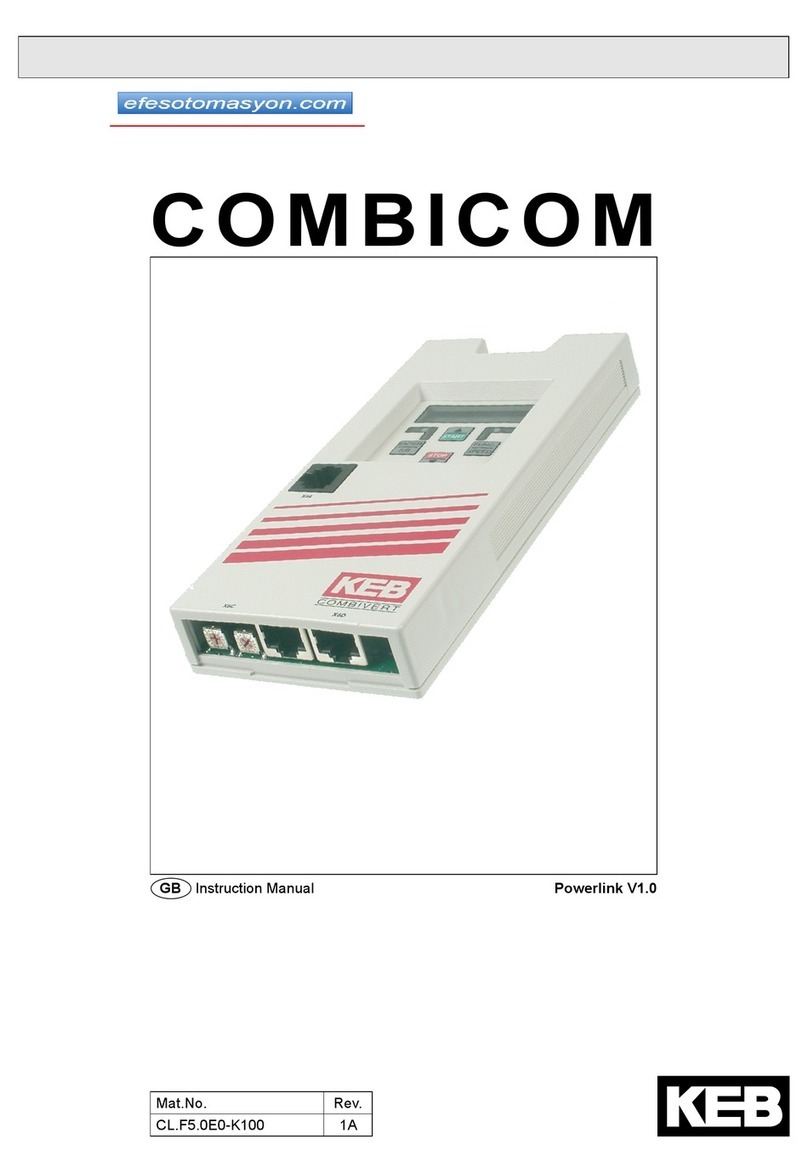
KEBCO
KEBCO COMBICOM User manual
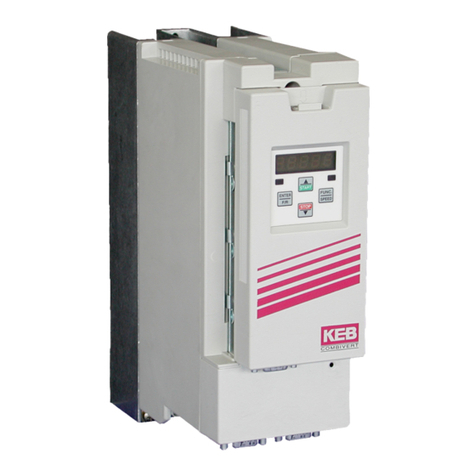
KEBCO
KEBCO COMBIVERT F5 User manual
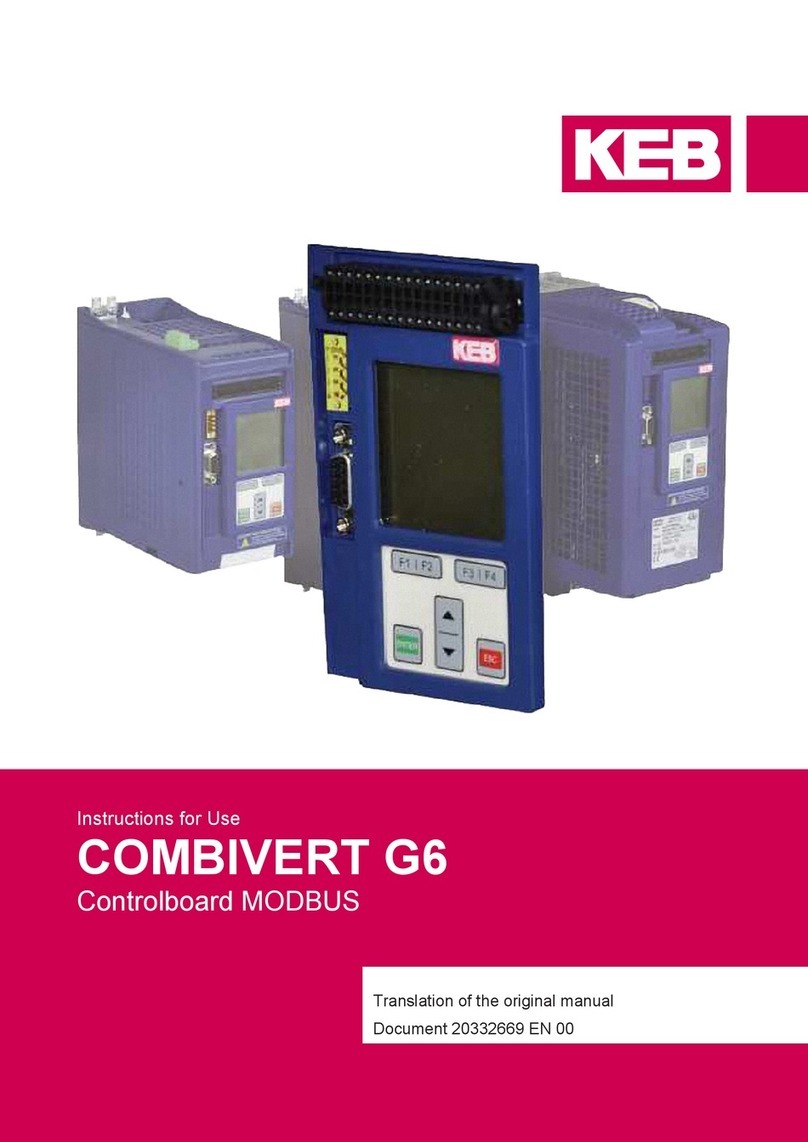
KEBCO
KEBCO COMBIVERT G6 User manual
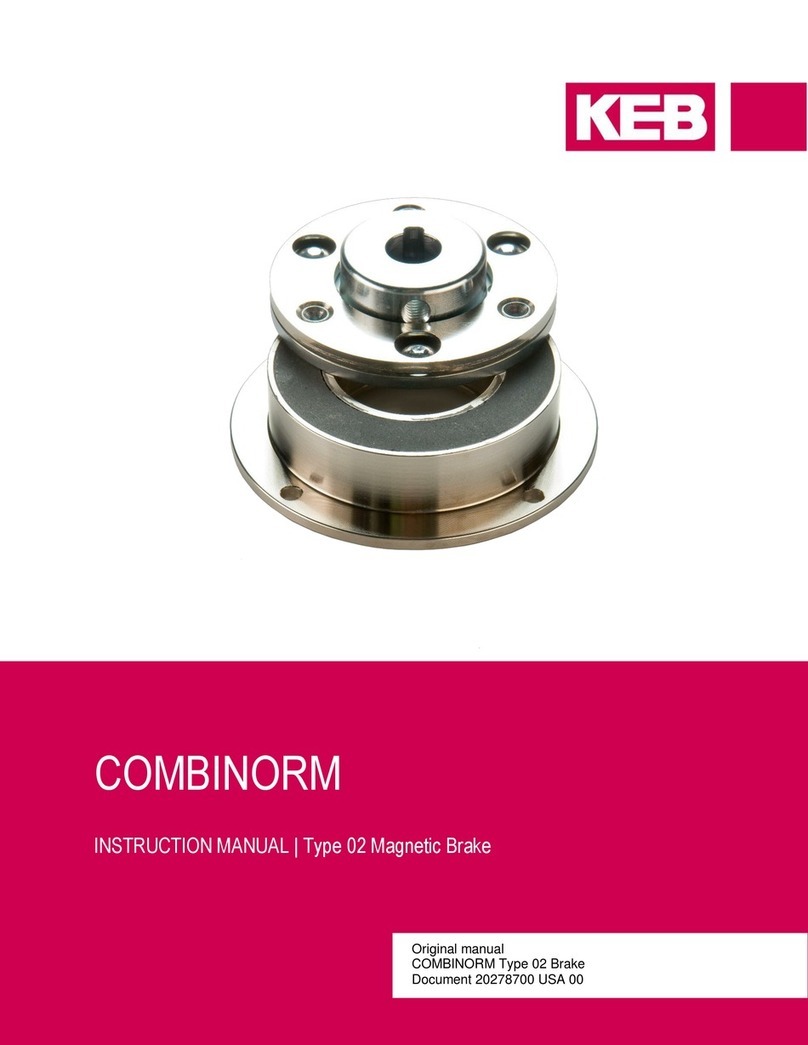
KEBCO
KEBCO COMBINORM User manual
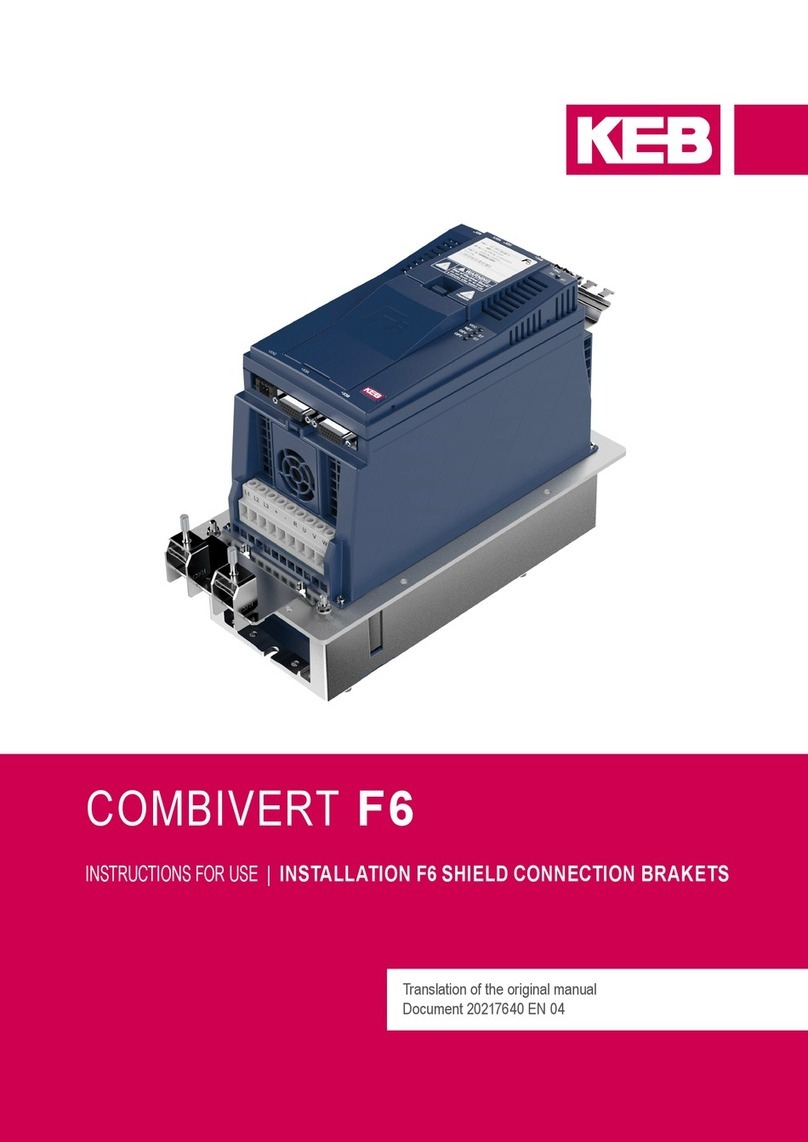
KEBCO
KEBCO COMBIVERT F6 User manual
